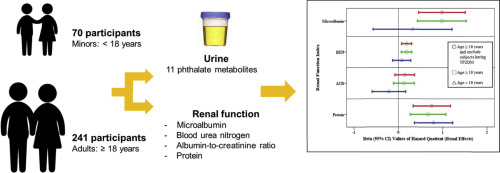International Journal of Hygiene and Environmental Health ( IF 6 ) Pub Date : 2019-11-26 , DOI: 10.1016/j.ijheh.2019.10.009 Jung-Wei Chang , Kai-Wei Liao , Chien-Yuan Huang , Han-Bin Huang , Wan-Ting Chang , Jouni J.K. Jaakkola , Chih-Cheng Hsu , Pau-Chun Chen , Po-Chin Huang

|
Studies have suggested that phthalates may be a risk factor for microalbuminuria, whereas little is known regarding their nephrotoxic effects on adults. We enrolled 311 participants (≥18 y, N = 241; <18 y, N = 70) who provided questionnaire information as well as blood and urine samples from a nationally cross-sectional study. Urinary phthalate metabolites were analyzed through liquid chromatography–tandem mass spectrometry. From the renal function index, we measured the serum level of blood urea nitrogen (BUN), and the urinary levels of microalbumin, albumin, protein and creatinine. We used multiple logistic regressions and a cumulative risk assessment of renal effect to evaluate the relationship between phthalate exposure and renal function in our participants.
We aimed to assess the relationship between phthalate exposure and renal function including serum level of BUN, and urinary levels of microalbumin, albumin, protein, and creatinine in 311 participants (≥18 y, N = 241; <18 y, N = 70) from a population-based study. The multiple logistic regression showed that the adjusted odds ratio of the highest tertile of estimated di-2-ethylhexyl phthalate (DEHP) daily intake in participants ≥18 y for early renal impairment (microalbumin >1.9 mg/dL) was 9.40 times higher (95% confidence interval = 1.67–52.84) than the lowest tertile. The cumulative hazard index of phthalate-induced nephrotoxicity (HInephro) was significantly positively associated with microalbumin (β: 0.98, P < 0.001), BUN (β: 0.19, P = 0.002), and urine protein (β: 0.75, P = 0.001) in participants ≥18 y without type 2 diabetes mellitus after adjusting for confounding factors, but not in those <18 y. Our findings suggest that daily exposure to DEHP and its metabolites were significantly positively associated with an increased risk of higher microalbumin in Taiwanese ≥18 y. Comprehensive or mechanistic studies are required to elucidate these associations.


























 京公网安备 11010802027423号
京公网安备 11010802027423号